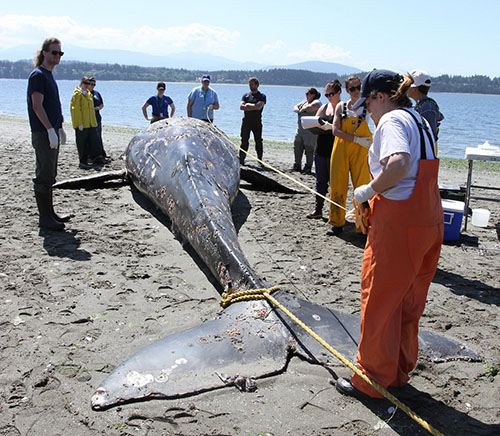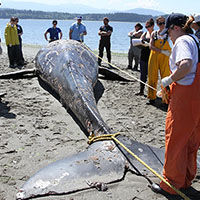— from Michael Milstein, Public Affairs Officer, NOAA Fisheries —
 A team from Cascadia Research Collective completed a necropsy Thursday afternoon on a juvenile gray whale that had been swimming injured through Puget Sound for about two weeks before dying over the weekend. Results and photos of the necropsy are available on the Cascadia website.
A team from Cascadia Research Collective completed a necropsy Thursday afternoon on a juvenile gray whale that had been swimming injured through Puget Sound for about two weeks before dying over the weekend. Results and photos of the necropsy are available on the Cascadia website.
NOAA Fisheries extends its appreciation to many agencies and organizations that assisted in tracking, monitoring and assessing the whale over the past two weeks. NOAA Fisheries especially appreciates the partnership of the U.S. Navy in providing a site on Indian Island where Cascadia’s team could complete the necropsy.
The gray whale was first sighted on April 24 off Kingston, Wash., and was active and swimming but appeared to be unable to dive. NOAA Fisheries coordinated a response by its West Coast Marine Mammal Stranding Network and other agencies. On April 30, Cascadia Research Collective and Washington Department of Fish and Wildlife’s Marine Mammal Investigations assessed the whale and found that it was approximately 35 feet long and likely a juvenile that was only a few years old.
On May 6, Cascadia Research Collective, Washington Department of Fish and Wildlife and the Seattle Aquarium conducted a secondary health assessment. The animal’s back showed sun damage and blistering from being exposed at the surface. Biologists and veterinarians suspected the whale may have been suffering from an infection that produced gas inside its body or a pneumothorax – a collapsed lung – that had filled its chest cavity with air. Either condition could have made the animal too buoyant to dive. Because gray whales feed by diving to the sea floor and sifting sediment for small marine organisms, such as tiny crustaceans, the animal’s injuries compromised its likelihood of survival.
NOAA Fisheries coordinated continued monitoring of the whale’s location and condition, but intervention was not an option. Gray whales weigh up to 40 tons and a distressed whale can be very dangerous. The tools do not exist to either treat or euthanize large, free-swimming marine mammals.
Subsequent sightings reported the whale ranging widely through Puget Sound, including near Vashon Island, West Seattle and Tacoma. The U.S. Coast Guard assisted with tracking the whale and notifying ship traffic of the whale’s location and movements.
On May 8, the whale was found dead in Elliott Bay off downtown Seattle, but it subsequently drifted north. Efforts to locate and tow the carcass on May 10 were unsuccessful. Cascadia Research Collective and the Washington Department of Natural Resources worked together on May 11 to tow the whale’s carcass to a site on Indian Island provided by the U.S. Navy for the necropsy. The necropsy results will help NOAA Fisheries understand the whale’s injuries and the cause of death, which could provide insight into the health risks affecting gray whales.
NOAA Fisheries thanks the many individuals, groups and agencies that assisted in monitoring the whale or supporting the effort, including Cascadia Research Collective, Washington Department of Fish and Wildlife’s Marine Mammal Investigations, Washington Department of Fish and Wildlife’s Enforcement, Washington State Parks, the U.S. Navy, Washington Department of Natural Resources, U.S. Coast Guard, Seal Sitters, Orca Network, Seattle Aquarium, and the SeaDoc Society.
NOAA’s mission is to understand and predict changes in the Earth’s environment, from the depths of the ocean to the surface of the sun, and to conserve and manage our coastal and marine resources. Join us on Facebook, Twitter and our other social media channels at www.noaa.gov/socialmedia.
**If you are reading theOrcasonian for free, thank your fellow islanders. If you would like to support theOrcasonian CLICK HERE to set your modestly-priced, voluntary subscription. Otherwise, no worries; we’re happy to share with you.**








